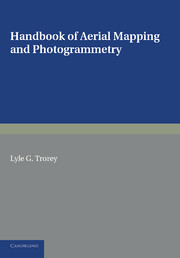Book contents
- Frontmatter
- Dedication
- FOREWORD
- PREFACE
- Contents
- LIST OF TABLES
- Bibliography
- Notation
- CHAPTER 1 PERSPECTIVE PRINCIPLES
- CHAPTER 2 MEASUREMENT OF ANGLES FROM OBLIQUES
- CHAPTER 3 PERSPECTIVE GRID AND FOUR-POINT METHODS
- CHAPTER 4 MEASUREMENT OF HEIGHT FROM A SINGLE OBLIQUE
- CHAPTER 5 VERTICALS: FUNDAMENTAL CONSIDERATIONS OF COVER, PARALLAX AND STEREOSCOPY
- CHAPTER 6 PARALLAX AND ELEVATION CALCULATIONS
- CHAPTER 7 RADIAL-LINE TRIANGULATIONS, GRAPHICAL AND MECHANICAL
- CHAPTER 8 RECTIFICATION MEANS
- CHAPTER 9 SUBDIVISIONS OF AN AIR SURVEY MAPPING OPERATION
- CHAPTER 10 PRINCIPLES OF STEREOSCOPIC PLOTTING INSTRUMENTS
- CHAPTER 11 THE MULTIPLEX PROJECTOR
- APPENDIX 1 STANDARD MAPPING PROCEDURE ROYAL CANADIAN ENGINEERS
- APPENDIX 2 MULTIPLEX AND STEREOPLANIGRAPH: CONSIDERATIONS GOVERNING MINIMUM CONTOUR INTERVAL
- APPENDIX 3 THE KELSH PLOTTER
- INDEX
CHAPTER 7 - RADIAL-LINE TRIANGULATIONS, GRAPHICAL AND MECHANICAL
Published online by Cambridge University Press: 05 June 2016
- Frontmatter
- Dedication
- FOREWORD
- PREFACE
- Contents
- LIST OF TABLES
- Bibliography
- Notation
- CHAPTER 1 PERSPECTIVE PRINCIPLES
- CHAPTER 2 MEASUREMENT OF ANGLES FROM OBLIQUES
- CHAPTER 3 PERSPECTIVE GRID AND FOUR-POINT METHODS
- CHAPTER 4 MEASUREMENT OF HEIGHT FROM A SINGLE OBLIQUE
- CHAPTER 5 VERTICALS: FUNDAMENTAL CONSIDERATIONS OF COVER, PARALLAX AND STEREOSCOPY
- CHAPTER 6 PARALLAX AND ELEVATION CALCULATIONS
- CHAPTER 7 RADIAL-LINE TRIANGULATIONS, GRAPHICAL AND MECHANICAL
- CHAPTER 8 RECTIFICATION MEANS
- CHAPTER 9 SUBDIVISIONS OF AN AIR SURVEY MAPPING OPERATION
- CHAPTER 10 PRINCIPLES OF STEREOSCOPIC PLOTTING INSTRUMENTS
- CHAPTER 11 THE MULTIPLEX PROJECTOR
- APPENDIX 1 STANDARD MAPPING PROCEDURE ROYAL CANADIAN ENGINEERS
- APPENDIX 2 MULTIPLEX AND STEREOPLANIGRAPH: CONSIDERATIONS GOVERNING MINIMUM CONTOUR INTERVAL
- APPENDIX 3 THE KELSH PLOTTER
- INDEX
Summary
The Radial-line Plot, Base-lining and Point Transference
Plumb Point and Isocentre. In a truly vertical photograph θ of fig. 1 is zero, hence the principal axis pSP is vertical and coincides with the plumb line, n and p are therefore coincident. It has been shown that height displacement is radial from n; in a vertical photograph it is thus radial from p since the plumb and principal point coincide.
It has also been shown that tilt displacement is radial from the isocentre i. This point too is coincident with the principal point of a truly vertical photograph. Whereas the tilt displacement in such a photograph is nil, the initial instantaneous direction of displacement due to tilt must be radial from p.
The Radial-Line Assumption. We therefore have the proposition that a vertical photograph is angle true with respect to its principal point. This is rigidly true if the tilt be zero quite regardless of the amount of relief. It is very nearly true for slightly tilted photographs where the relief is not great compared to the flying height. This approximation is known as the radial-line assumption. The magnitude of the error involved is discussed below.
Needle Pricks and Scribed Lines. A fine needle, held in a pin vice, is used as a scriber and pricker. Scribed lines must be fine and must be straight; a good 12 in. steel straight edge should be used. Their visibility may be improved by ‘inking in’ with chinagraph, after which the excess wax is removed with a soft cloth. Needle pricks must be of the smallest size consistent with subsequent re-identification. Pricked points should be ringed with a rather large chinagraph circle, large so that stereoscopy of the adjacent area is not interfered with. The back of the photograph may be suitably annotated.
Skill in the use of the needle must be developed by anyone wishing to do serious photogrammetric work. Pricks should be of such size that a small luminous point is seen when the picture is held up to a light source.
The tendency is to make needle pricks which, to scale, are of astounding size. A good object lesson consists in measuring some rejected work with a low-power microscope (Leitz glass). On a 1:60,000 photograph a needle prick ¼ mm. in diameter represents a 50 ft. crater on the ground.
- Type
- Chapter
- Information
- Handbook of Aerial Mapping and Photogrammetry , pp. 93 - 108Publisher: Cambridge University PressPrint publication year: 2013



